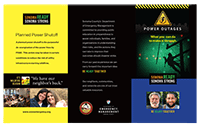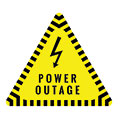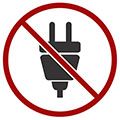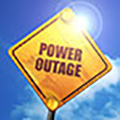Based on certain conditions, which include Red Flag Warnings, winds, low humidity, fuel loads, and observable conditions, PG&E may shut off the power anywhere in Sonoma County. Power could be out for a number of days depending on conditions. Stay informed about outages affecting your service on the PG&E Outage map here: https://pgealerts.alerts.pge.com/outages/map/
Learn more about Red Flag Warnings, what they mean and which activities are discouraged during Red Flag conditions.
 Print the lists below or download “Power Outages: What you can do to make it through” and keep these lists handy in case the power is turned off.
Print the lists below or download “Power Outages: What you can do to make it through” and keep these lists handy in case the power is turned off.
Remember, the conditions that cause PG&E to turn off the power also mean we have a high risk of wildfire during this time. For information about wildfire preparedness and Red Flag Warnings, see Wildfire Readiness.
Prepare for possible loss of power:
If PG&E has informed you of a potential power shutoff in your area, here are key steps to take:
- Make sure PG&E has your current contact information. Update your contact information with PG&E online or call (866) 743-6589.
If you have lifesaving medical equipment:
- Verify PG&E has you registered with their Medical Baseline Allowance program,
- Plan to have back-up power sources for all critical medical needs (including refrigerated lifesaving medications), and
- Have pre-established connections with nearby family or neighbors to assist if needed.
- Talk to your medical provider about a power outage plan for medical devices powered by electricity and refrigerated medicines.
- Have a back-up charging system for cell phones and keep devices fully charged at all times.
- Test your battery-powered radios and flashlights.
- Consider alternate power generation choices for your home or critical business systems. Be sure to follow all safety instructions for stand-alone power generators. See Portable Generator Safety Tips for more information.
- Keep vehicle gas tanks full (gas pumps may be without power) and electric vehicles fully charged and park it outside. Familiarize yourself with how to manually open the garage door.
- Identify a place you can go to cool off, if necessary.
- Keep some cash on hand (credit/debit stations and ATMs may be without power).
- Check and update your go bag and emergency kit and supplies (include hard copies of critical information and life-saving prescriptions). Review the supplies that are needed in case of a power outage including flashlights, extra batteries food and water for every household member.
- Learn more about PG&E Power Shutoffs in your area and work with your neighbors to make sure everyone is ready.
- Reach out to neighbors who may need assistance and help them prepare.
- While the County of Sonoma will not issue an evacuation notice for a power outage, the weather forecast includes high fire danger. Sign up to receive evacuation notices at SoCoAlert.com.
 If PG&E has warned of a power shutoff:
If PG&E has warned of a power shutoff:
If PG&E is planning to turn off your electricity within the next 48 hours, here are some important things to do now:
- Make sure cell phones and back-up batteries are fully charged. Check your battery-operated radio and flashlights.
- Fill up your car with gas and leave it out of the garage. (You should also learn how to manually open the garage door!)
- Place your go bag or emergency kit in the car so if you’ll be ready if you need to leave in a hurry.
- Fill some water bottles (3/4 full only) and place them in the freezer to help keep things cool (remember, if you leave the doors of the refrigerator closed it will remain cool for many hours).
- Make sure you have cash.
- Check with PG&E for information about their plans and if they are going to open a community resource center.
- Check with your local government for cooling centers that may be available.
- Contact your neighbors who may need help and help them get ready.
 If your power is out:
If your power is out:
- Use your cell phone sparingly to preserve power. Text when possible, in lieu of voice calls. Keep family up to date about how you are doing.
- Keep hydrated and seek out cooling centers if needed.
- Try to keep your refrigerator doors closed. Use the most perishable items first. Items which fully thaw (above 40 degrees) must be used within 4 hours or thrown out.
- If you have a generator, be sure to follow safety instructions and use only as needed to save fuel. Always allow the generator to cool completely before refueling.
- If you have relatives or friends in other areas that still have power, take this opportunity to visit them.
- Check on your neighbors and help each other stay safe.
Food Safety After a Power Outage
Food that has been out of temperature for more than 4 hours may cause illness. Discard all spoiled food to avoid potential health risk.
Take special care in handling potentially hazardous food (PHF). PHF is moist, perishable food in and on which bacteria can grow. PHF must be maintained at a temperature below 41° F in your refrigerator and below 0° F degrees in your freezer.
If your home was impacted by a power outage, special considerations are necessary to ensure the safety of food in refrigerators or freezers.
- When the power goes out, keep refrigerator and freezer doors closed as much as possible.
- Check for signs of power outage such as liquid or refrozen meat juices, soft or melted ice cream.
- Discard any food that has an unusual color, odor, or texture.
- Discard perishable foods (including meat, poultry, fish, eggs and leftovers) in your refrigerator when the power has been off for 4 hours or more.
- Thawed food that contains ice crystals can be refrozen or cooked. Freezers, if left unopened and full during a power outage, will keep food safe for 48 hours (24 hours if half full).
- Reheating food that has become contaminated will not make it safe!
- When in doubt, throw it out!

